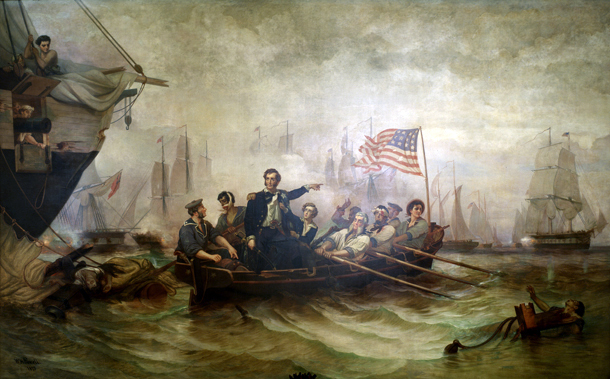This is a curated list of Titanic news for the first part of April 2022. I will be posting the second half soon.
===
Titanic News-April 2022
March 31-April 15, 2022
*29 Shipwrecks Found Since the Discovery of the Titanic
247wallst.com, 31 Mar 2022
https://247wallst.com/special-report/2022/03/31/29-shipwrecks-found-since-the-discovery-of-the-titanic/
Finding a shipwreck has been the stuff of fantasy for as long as people have sought opportunities beyond the horizon. There is no shortage of wrecked vessels to find; it’s estimated that there are more than three million undiscovered shipwrecks around the world.
*Molly Brown House Opens New Titanic Exhibit With More Unseen Artifacts
4CBS Denver, 1 April 2022
https://denver.cbslocal.com/2022/04/01/titanic-molly-brown-house-unseen-artifacts-denver-museum/
Many of the artifacts are associated with “Unsinkable” Molly Brown, who survived the Titanic’s sinking and is one of the most well-known women in Denver’s history. “Heroine of the Titanic” opened on Friday at the Molly Brown House, 1340 Pennsylvania Street. It will be open for visitation on select days through late September.
*12 Artifacts Brought Up From the ‘Titanic’
Mental Floss, 2 April 2022
https://www.mentalfloss.com/posts/titanic-shipwreck-recovered-artifacts
Since 1987—two years after the Titanic wreck was discovered—seven trips have been made to the ship’s debris field, and more than 5500 artifacts have been salvaged. Here are a few of them.
*Titanic Artifact Goes On Display For The First Time Since 1912
Attractions Magazine, 2 April 2022
https://attractionsmagazine.com/titanic-artifact-goes-on-display-for-the-first-time-since-1912/
On April 5, 2022, Titanic Museum Attraction will unveil the charm-like embellishment, which was once attached to Straus’s watch fob chain, to a gathering of select members of the media, Straus’s great-great-grandson David Kurzman, and others, marking the first time the public will see it since 1912.
*Rare Illustrated Brochure Is Set To Sell At Auction For £6,000
Daily Mail, 2 April 2022
https://www.dailymail.co.uk/news/article-10679139/Rare-111-year-old-brochure-Titanic-set-sell-auction-6-000.html
A rare holiday brochure for the Titanic has surfaced 111 years after it was originally produced. The brochure is being sold by a private collector who uncovered it in Northern Ireland several years ago on April 23 and is expected to sell for £6,000.
*Woman Shares Stories of Titanic Passengers for Anniversary of Sinking
Newsweek, 4 April 2022
https://www.newsweek.com/woman-shares-stories-titanic-passengers-anniversary-sinking-viral-tiktok-1694891
A series of videos is gaining traction on TikTok as a woman has decided to share the stories behind various passengers on the Titanic for each day in April—the month the ship sunk over 100 years ago. TikToker @kjdish, whose name is Kaylee Jukich-Fish began the series on April 1 which she calls “Titanic Month” by going through a stack of “boarding passes” from passengers on the ship. The first video has now received over 1 million views in which Jukich-Fish talks about the life of passenger, and survivor, Annie “Nina” Harper.
*The Legend of Jenny, the ‘Titanic’ Cat Said to Have Predicted the Ship’s Fate
Mental Floss, 4 April 2022
https://www.mentalfloss.com/posts/jenny-titanic-cat
Titanic’s resident feline, who joined the ship while it was still in Belfast, didn’t receive the same first-class treatment as the canine passengers that boarded the ocean liner with their owners. Jenny was a ship cat, meaning she was allowed to roam the decks freely and help keep the rat population under control. With no one to smuggle her into a lifeboat—as was the case with two lucky Pomeranians and one Pekingese on board—Jenny’s story likely didn’t have a happy ending. The cat never turned up after the ship sank into the Atlantic, and she was presumed dead.
*Isidor Straus Fob On Display At Pigeon Forge’s Titanic Museum
WVLT8, 5 April 2022
https://www.wvlt.tv/2022/04/05/isidor-straus-fob-display-pigeon-forges-titanic-museum/
The fob, a charm for men’s pocket watches, is on exclusive display for the first time since 1912 at the museum. Isidor Straus wore the fob the night he died during the Titanic’s sinking. Straus’s body was found and the artifact was returned to his family, who has had it for over 100 years.
*Grimm Prospects: Jack Grimm, the Eccentric Billionaire Hell-Bent On Finding the ‘Titanic,’ Bigfoot, and Noah’s Ark
Mental Floss, 5 April 2022
https://www.mentalfloss.com/posts/jack-grimm-explorer-titanic-bigfoot
It was 1980, and Grimm, an oil tycoon, was organizing yet another of his seemingly impossible quests. After searching for the remains of Noah’s Ark, evidence of Bigfoot, and proof of the Abominable Snowman, Grimm had set his sights on finding the wreckage of the Titanic, which had sunk to the depths of the North Atlantic in 1912. No one had located the ship. Grimm believed he could—with the aid of a monkey named Titan.
*Titanic Survivor Molly Brown’s Blanket To Go Under The Hammer
Independent, 6 April 2022
https://www.independent.co.uk/news/uk/belfast-harland-and-wolff-errol-flynn-new-york-american-b2052008.html
“As part of the sale, Molly’s White Star Line embroidered deck chair blanket, which was in her possession when she was travelling on the Titanic, will be going under the hammer, as will an engraved trinket box that was given to Molly by her husband upon her safe return to New York,” he said. The auction catalogue for the sale, which will take place on April 26 in house and online, is now available to view: www.bloomfieldauctions.co.uk
*Titanic’s 110th Anniversary: One Of Only Six Life Jackets Remaining From Ship To Be Displayed In Belfast Museum
Belfast Telegraph, 7 April 2022
https://www.belfasttelegraph.co.uk/archive/titanic/titanics-110th-anniversary-one-of-only-six-life-jackets-remaining-from-ship-to-be-displayed-in-belfast-museum-41529595.html
One of only six life jackets remaining from the Titanic has gone on display at the Titanic Belfast museum to commemorate the 110th anniversary of its sinking. This is the first time the life jacket has been on public display on the island of Ireland and it is free for the public to view in the Grand Atrium of Titanic Belfast until Sunday, April 24.
*110th Anniversary Of Titanic To Take Place In Cobh Over The Weekend
Irish Times, 7 April 2022
https://www.irishtimes.com/news/ireland/irish-news/110th-anniversary-of-titanic-to-take-place-in-cobh-over-the-weekend-1.4847141
The 110th anniversary of the sinking of the Titanic with the loss of 1,504 lives will be remembered in Cobh this weekend. Members of the British Titanic Society (BTS) will travel to the Cork Harbour town to lay a wreath at the spot that the White Star liner departed from on her ill-fated maiden voyage. Over 80 members of the British Titanic Society will travel to Cobh for the society’s 2022 convention where they will travel to Roches Point on Friday to lay a wreath at the point from where the liner departed from Ireland en route to New York.
*6 Facts About ‘Titanic’ Survivor Eva Hart, One of the Last to Remember the Disaster
Mental Floss, 8 April 2022
https://www.mentalfloss.com/posts/eva-hart-titanic-survivor-facts-history
Seven-year-old Eva Hart boarded the Titanic with her family on April 10, 1912, not knowing that her life was about to change forever. In her later years, she had the distinction of being one of the last living Titanic survivor with first-hand memories of the disaster. Here are six facts about Eva Hart’s role in history.
*Key Facts On Titanic And Belfast — 110 Years After It Sailed On Its Fateful Transatlantic Voyage
News Letter, 10 April 2022
https://www.newsletter.co.uk/heritage-and-retro/heritage/key-facts-on-titanic-and-belfast-110-years-after-it-sailed-on-its-fateful-transatlantic-voyage-3648285
(The article is fine but they should have edited it more carefully. In some places, time travel took place as dates such as 2011 are used!)
The Titanic link to Belfast has its origins almost half a century earlier, when White Star Line in 1869 chose Harland and Wolff in the city to commence construction of vessels to rival Cunard Line, which was the main shipping service across the Atlantic.
*Remembering Titanic Victim ‘Tom’ Kerley Of Bowerchalke
Salisbury Journal, 10 April 2022
https://www.salisburyjournal.co.uk/features/journalfeatures/20055511.remembering-titanic-victim-tom-kerley-bowerchalke/
William Thomas Kerley lived at Woodminton Cottages, Bowerchalke and on the release of the Titanic film ‘A Night to Remember’ in 1957, many locals came forward to say they knew “Tom” Kerley. Mr Will Case knew the Kerley family, as did a Mrs Hardiman, of Shaftesbury, who reported in 1957: “The young man Tommy Kerley, as he was called, had two brothers and four or five sisters. The family left Bowerchalke soon after the disaster.”
*Brooch From Titanic With Jack And Rose-Like Love Story Up For Auction
New York Post, 11 April 2022
https://nypost.com/2022/04/11/brooch-dating-back-to-the-titanic-ship-goes-up-for-auction/
Titanic survivor Roberta Maioni was just 20 years old when she found romance with a young gentleman steward aboard the ill-fated voyage. The first-class passenger fell in love with an unnamed crew member, who gifted her a white brooch the night of the ocean liner’s sinking.
*When Did Titanic Sink And How Long Did It Take? A Timeline Of The Disaster
History Extra, 13 April 2022
https://www.historyextra.com/period/edwardian/when-did-titanic-sink-how-long-timeline-disaster/
As day turned to night on 14 April 1912, little did passengers and crew on board Titanic know of the horrors that lay ahead. Nige Tassell tracks a timeline of how the disaster unfolded…
*Divine Mercy And The Sinking Of The Titanic
National Catholic Register, 12 April 2022
https://www.ncregister.com/blog/titanic-and-divine-mercy
Father Byles worked as quickly and as calmly as he could to usher the women and children to the lifeboats. The characteristic of the priest most in evidence, and the one most remarked on later by survivors, was his presence of mind throughout. It was as if this moment was the one for which he had been preparing all his life. Seeing the first batch of women and children safely aboard lifeboats, and declining an offer to join them, he quickly descended once more below decks.
*Titanic Passengers: 8 Stories Of People Who Sailed On The Liner
History Extra, 13 April 2022
https://www.historyextra.com/period/edwardian/titanic-passengers-stories-people-who-sailed-on-board/
Titanic brought people together from all levels of society – from the wealthy to those seeking a new start. From a future Olympian to the architect who went down with his ship, uncover the tales of those who were on board…
*Titanic Shipyard Wins Britain’s First Cruise Ship Contract In 50 YEARS As UK Economy Soars
Express, 13 April 2022
https://www.express.co.uk/news/uk/1595204/Titanic-shipyard-queen-victoria-belfast-cruise-ship-P-O
Harland & Wolff will now undertake works on P&O Cruises’ ship Aurora and Cunard’s Queen Victoria. When the work begins, the Queen Victoria will be the largest cruise ship ever to have dry docked in a UK yard. Prior to the planned work, the last cruise liner built by Britain was the Saga Ruby, built in 1973 in Newcastle upon Tyne.
*Enduring Mystery: Do These Photos Show The Iceberg That Sank The Titanic?
Yahoo, 13 April 2022
https://news.yahoo.com/enduring-mystery-photos-show-iceberg-172036577.html
One such photo showing an iceberg that, experts say, the massive Titanic ocean liner may have likely struck before sinking to the bottom of the Atlantic, is the first one believed to be taken by a passenger on the S.S. Carpathia, a passenger ship re-routed to help to the sinking Titanic.
*The Titanic Sank 110 Years Ago. An Indy Newspaper Got The Story Very Wrong.
IndyStar, 15 April 2022
https://www.indystar.com/story/news/history/retroindy/2022/04/15/titanic-anniversary-indianapolis-star-newspapers-covered-tragedy/7008835001/
By now, we all know this story. One hundred and ten years ago, during her maiden voyage, the RMS Titanic — then the world’s most luxurious liner, deemed “unsinkable” because of her state-of-the-art safety features — struck an iceberg in the north Atlantic Ocean and sank, killing 1,500 passengers. Although, for Indianapolis residents in 1912, that kind of depended on where you got your news.
















